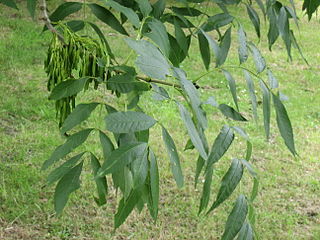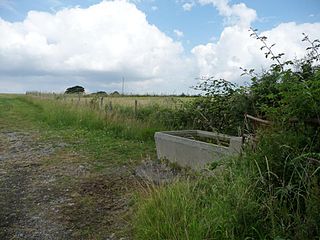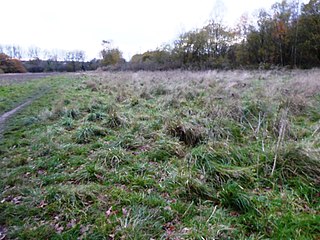| Site of Special Scientific Interest | |
 | |
| Area of Search | Surrey |
|---|---|
| Grid reference | TQ 029 700 [1] |
| Interest | Biological |
| Area | 6.4 hectares (16 acres) [1] |
| Notification | 1985 [1] |
| Location map | Magic Map |
Thorpe Hay Meadow is a 6.4-hectare (16-acre) biological Site of Special Scientific Interest west of Staines-upon-Thames in Surrey. [1] [2] It is owned and managed by the Surrey Wildlife Trust. [3]

A Site of Special Scientific Interest (SSSI) in Great Britain or an Area of Special Scientific Interest (ASSI) in the Isle of Man and Northern Ireland is a conservation designation denoting a protected area in the United Kingdom and Isle of Man. SSSI/ASSIs are the basic building block of site-based nature conservation legislation and most other legal nature/geological conservation designations in the United Kingdom are based upon them, including national nature reserves, Ramsar sites, Special Protection Areas, and Special Areas of Conservation. The acronym "SSSI" is often pronounced "triple-S I".
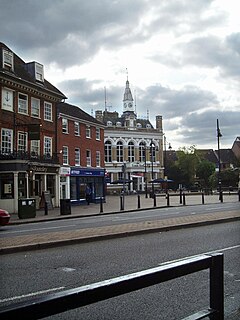
Staines-upon-Thames is a town on the River Thames in Surrey, England. Historically part of Middlesex, it was known to the Romans as Pontes or Ad Pontes, then as Stanes and subsequently Staines.

Surrey is a subdivision of the English region of South East England in the United Kingdom. A historic and ceremonial county, Surrey is also one of the home counties. The county borders Kent to the east, East and West Sussex to the south, Hampshire to the west, Berkshire to the northwest, and Greater London to the northeast.
Its habitat is (acid-alkali) neutral grassland and it contains Cynosurus cristatus - Centaurea nigra grassland as a notified feature. [4]

Cynosurus cristatus, Crested dog's-tail, is a short-lived perennial grass in the family Poaceae, characterised by a seed head that is flat on one side. It typically grows in species rich grassland. It thrives in a variety of soil types but avoids the acid and calcareous extremes of pH, and prefers well drained soils. It may be grown as an ornamental plant.
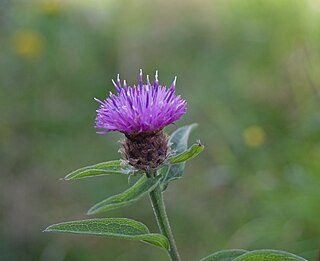
Centaurea nigra is a species of flowering plant in the daisy family known by the common names lesser knapweed, common knapweed and black knapweed. A local vernacular name is hardheads.
The site is thought to be the last remaining example of a Thames valley hay meadow in Surrey. It contains a range of lime-loving (calcicole) plants which are characteristic of this type of meadow. The grassland is dominated by rough-stalked meadow grass Poa trivialis , crested dog’s-tail grass Cynosurus cristatus, and lesser knapweed Centaurea nigra. Yellow rattle Rhinanthus minor , meadow-fescue grass Festuca pratensis , meadow barley Hordeum secalinum , smooth hawk’s-beard Crepis capillaris and common reed Phragmites australis are locally abundant, the last species being unusual in such dry situations. Other frequent species include meadow brome Bromus commutatus , a grass only recorded from one other Surrey location in recent years, meadow foxtail grass Alopecurus pratensis , Yorkshire-fog grass Holcus lanatus , pepper saxifrage Silaum silaus and meadow-sweet Filipendula ulmaria . Associated calcicole species include meadow cranesbill Geranium pratense , clustered bell-flower Campanula glomerata , cowslip Primula veris , hoary plantain Plantago media , salad burnet Sanguisorba minor and lady’s bedstraw Galium verum .
Poa trivialis, is a perennial plant regarded in the US as an ornamental plant. It is part of the grass family.
Rhinanthus minor, the yellow rattle, little yellow rattle, hayrattle or cockscomb, is a flowering plant in the genus Rhinanthus in the family Orobanchaceae, native to Europe, northern North America, and Western Asia.
Festuca pratensis, the meadow fescue, is a perennial species of grass, which is often used as an ornamental grass in gardens, and is also an important forage crop.
The meadow is surrounded by old hedgerows with a variety of species such as ash Fraxinus excelsior , hawthorn Crataegus monogyna , field maple Acer campestre , spindle Euonymus europaeus , dogwood Cornus sanguinea , and buckthorn Rhamnus catharticus . A drainage ditch along two sides of the site supports five species of willow including purple willow Salix purpurea and almond willow Salix triandra . Common comfrey Symphytum officinale , ragged robin Lychnis flos-cuculi , cyperus sedge Carex pseudocyperus and the uncommon aquatic liverwort Riccia fluitans ...along this ditch.
Fraxinus excelsior, known as the ash, or European ash or common ash to distinguish it from other types of ash, is a flowering plant species in the olive family Oleaceae. It is native throughout mainland Europe east to the Caucasus and Alborz mountains. The northernmost location is in the Trondheimsfjord region of Norway. The species is widely cultivated and reportedly naturalised in New Zealand and in scattered locales in the United States and Canada.
Crataegus monogyna, known as common hawthorn, oneseed hawthorn, or single-seeded hawthorn, is a species of hawthorn native to Europe, northwest Africa and western Asia. It has been introduced in many other parts of the world. It can be an invasive weed.
Acer campestre, known as the field maple, is a flowering plant species in the soapberry and lychee family Sapindaceae. It is native to much of Europe, the British Isles, southwest Asia from Turkey to the Caucasus, and north Africa in the Atlas Mountains. It has been widely planted, and is introduced outside its native range in Europe and areas of USA and Western Australia with suitable climate.
— Species listed in Citation, 1985, Natural England [4]
A footpath from Staines passes through the site.



